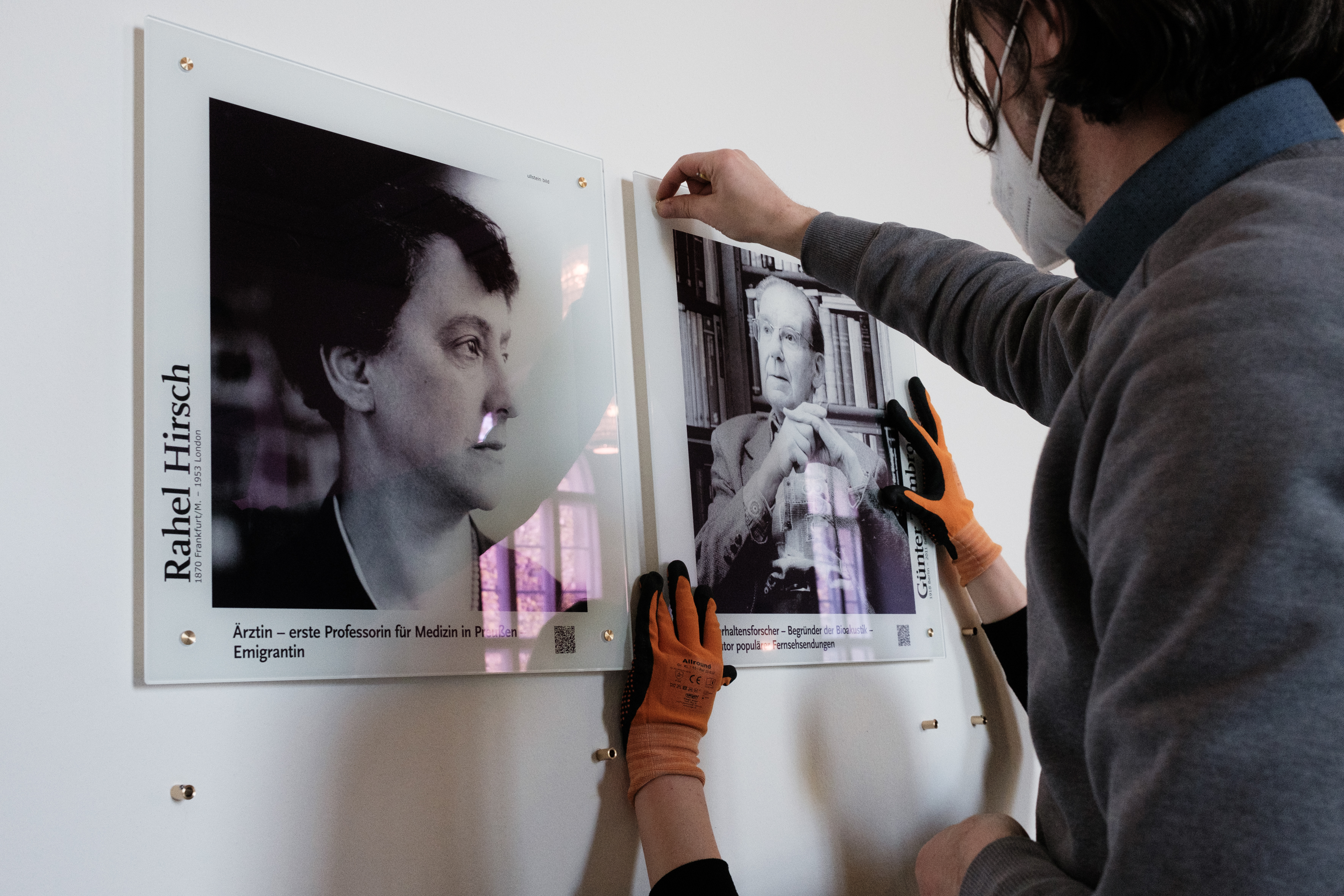Science and responsibility

The new gallery in the foyer of the Humboldt-Universität was installed in April.
Shown in the picture here: Rahel Hirsch and Günter Tembrock
(Photo: HU/P. Plum)
For more than ten years, the portraits of 29 Nobel Prize winners closely associated with the Humboldt-Universität have welcomed the university’s members and guests in front of the meeting chamber of the University Senate in the main building on Unter den Linden. A newly designed gallery now expands this group of memorable Humboldtians to include figures who have shaped the self-image and profile of Berlin’s oldest university throughout its history.
In the new portrait exhibition “Excellence in Science – The University for Society” in front of the Senate Chamber, visitors and members of the university will encounter more than 40 women and men who have had a decisive impact on the development of the Humboldt-Universität and science nationally and internationally: excellent academics with a great sense of responsibility and high level of commitment towards society, but also outstanding researchers with problematic biographies. The exhibition replaces the gallery of Nobel laureates which had been hanging since 2011.
In recent years, there had been repeated criticism of how the focus of remembrance in this special site was placed on the Nobel Prize winners – especially from the ranks of the students. In December 2013, for example, activists “kidnapped” the portrait of Adolf Butenandt. The biochemist was a member of the National Socialist German Workers’ Party, collaborated closely with Nazi researchers and was one of the co-signatories of a “Vow of Allegiance” of professors “to Adolf Hitler and the National Socialistic State” in 1933. Butenandt was a professor at the University of Berlin from 1938 to 1944. In 1939, he was awarded the Nobel Prize for his research on female sex hormones.
Broader understanding of scientific excellence
The new exhibition was conceived of and planned by the members of the Humboldt-Universität’s Historical Commission. “White men who have won a Nobel Prize are, as a matter of principle, no longer suitable for being the sole role models for a university whose understanding of scientific excellence is much broader today,” says Prof. Dr Gabriele Metzler, Chair of the Historical Commission. “Our understanding of what the Humboldt-Universität stands for and wants to stand for goes beyond outstanding achievements in science. It always comprises questions of responsibility in science and commitment to society, especially if this is tied to moral courage and extraordinary bravery. Remembrance in this context is always controversial and shall remain so.”
Some of those whose portraits are on display include Regine Hildebrandt, W.E.B. du Bois, Alice Salomon, Dietrich Bonhoeffer, Robert Havemann, Rahel Hirsch, Günther Tembrock, Karl Marx, Jurek Becker, Elisabeth Schiemann, Magnus Hirschfeld and Lieselotte Richter – all scientists and figures who distinguished themselves not only through their scientific achievements but also through their fight against injustice and on behalf of other people.
However, one can also find outstanding scientists who are now viewed and judged critically on the basis of their actions, the consequences of their research, or their ethical values – the chemist and Nobel laureate Fritz Haber, for example, whose research enabled the mass production of nitrogen fertilisers, thus making an important contribution to feeding the ever-growing world population, but who also promoted the use of poison gas in the First World War.
University is not a detached ivory tower
The claim to being a research university, as was already formulated by founder Wilhelm von Humboldt, evidently remains intact. The attainment of the university and its members is now being documented across its entire history, spanning the practice of all disciplines.
At the same time, the intention is to make clear that the University of Berlin was never an ivory tower, detached from the world, but always part of society. This also transpired within problematic alliances. One need only think of militaristic and racist research, participation in the planning of Nazi genocides, or the legitimation of dictatorial rule. This also took the form of marginalisation of undesirable groups, as has been experienced by Jews, women, Catholics, people of colour and political dissidents – to name just a few.
With an eye to teaching and research, and the achievement of its students – and by way of example, but open to expansions in future – the HU wishes, above all, to point out the productive impetus that has emanated from this university with respect to the design and reformation of state and city, culture and politics, science and society.
Further information
The new exhibition was presented to the public on 26th April. It is located in the main building on the first floor, in front of the Humboldt-Universität’s Senate Chamber.
Learn more about the personalities featured in the new exhibition on the HU homepage (in German, the english website is coming soon).
Contact
Hans-Christoph Keller
Press Spokesperson of the Humboldt-Universität zu Berlin
